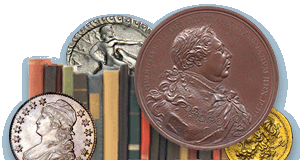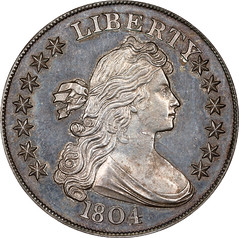
PREV ARTICLE
NEXT ARTICLE
FULL ISSUE
PREV FULL ISSUE
MORE ON THE 16TH 1804 DOLLAR PROVENANCESteve Hill of Sovereign Rarities writes:
Len Augsburger writes: "The piece was a bit speculative, but stirring the pot can be a good thing. Edgar Adams is as good a guess as any." Bill Eckberg writes: "Wholesale returns of conjecture out of such a trifling investment of fact. (Apologies to Mark Twain)" The article's author Doug Ward writes: "We'll see what appears, but unless Mr. Stack had a journal or ledger it's likely to be nothing but speculation... In such an event, there are very few other 'logical' choices. Unfortunately, numismatic history is littered with those more concerned in the end with their vanity, than with documenting their transgressions. Circumstantial evidence is all that remains. " Yes, the idea is speculative, and hedged with words and phrases like "I would postulate" and "probably". As noted earlier, the auction catalog description for the James A. Stack 1804 Dollar has yet to be written and published, so stay tuned on the provenance of this piece. Clues that may have been overlooked before will be reviewed in the new light of this discovery and the inevitable speculation it spawns. As Len noted, Edgar Adams is a logical choice. But not the only one. The Fantastic 1804 Dollar has been the stuff of fantasy since its murky beginnings, so the latest discussions are only par for the course. And we'll look forward to more. Here's a taste - Craig Sholley and John Dannreuther submitted the following. -Editor
Comments on the 16th 1804 Dollar and the Infamous Half Union Debacle
We read Douglas Ward's article discussing the provenance of the 16 th known 1804 dollar and the Woodin fifty dollar ("half union") pattern debacle in the Aug. 31, 2025 issue of The E-Sylum and wish to point out several inaccuracies. First, the historical record shows that it was Henry Linderman, not A. Loudon Snowden, who was behind the majority of the restriking prior to his death in 1879. Both mint records and historical auction records show that large-scale restriking for profit began at the mint in the mid-1850s and continued unabated through early 1864. During that time Linderman was the "Director's Clerk." While that may sound like a minor clerical position, it was anything but. The mint's "Rules and Regulations," first written in 1795, reveal that the Director's Clerk was responsible for overseeing the day-to-day operations of the mint, including work assignments and ensuring the work was proceeding on schedule. He was literally the plant manager. He had all of the keys to the vaults and the combinations to the safes. At this same time, A. Loudon Snowden was the "Registrar of Deposits," responsible for logging-in and recording all of the information about bullion deposits at the mint. He had nothing to do with coining or any other manufacturing operation. Linderman chose him as a partner-in-crime mainly because he was Mint Director James Ross Snowden's nephew. So, if Linderman was fired for his activities, the Director's nephew would also go, embarrassing James Ross and the entire family. Imagine explaining that one at the next family get-together.
We presented much of this information in several articles including "Gobrecht Dollar
Restrike and Cabinet Coins" in the June 2016 issue of The Numismatist and "The
Supposed Destruction of the Proof Half Cent Restrike Dies" in the January 2023 issue
of Pennywise. A summary is also available on the "DTS Die Stating Guide" website at
As to the infamous half union pattern debacle, letters between Woodin and his lawyers discussing the matter came to light in 2004. The letters reveal that A. Loudon Snowden had sold the half union patterns to Woodin. When the government threatened legal action to recover them, Woodin returned the disputed pieces to A. Loudon, who summarily returned them to the mint, and repaid Woodin by giving him two trunks of patterns he had taken from the mint on his departure.
Dannreuther discussed these letters in his article, "William Woodin's Purchase of Two
Gold Half Unions" in the March 2013 issue of The Numismatist. Subsequently, Saul
Teichmann published the main letter detailing the origin of the patterns and their return
on US Patterns website under the listing for the half unions, Judd-1546, available at:
As to the 1804 dollars, new information has recently come to light which shows that Henry Linderman was responsible for both the Class II and Class III dollars. We will be presenting that information in an upcoming article.
To read the earlier E-Sylum articles, see:
Wayne Homren, Editor The Numismatic Bibliomania Society is a non-profit organization promoting numismatic literature. See our web site at coinbooks.org. To submit items for publication in The E-Sylum, write to the Editor at this address: whomren@gmail.com To subscribe go to: Subscribe All Rights Reserved. NBS Home Page Contact the NBS webmaster 
|

